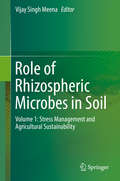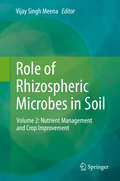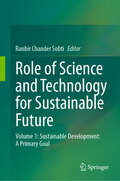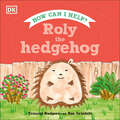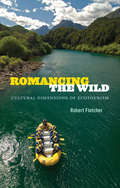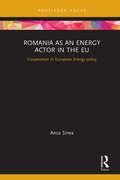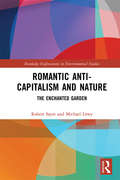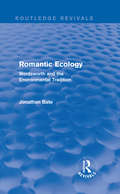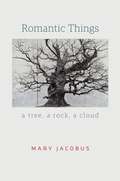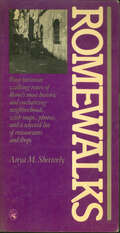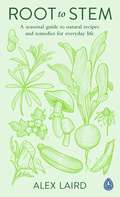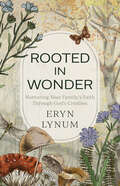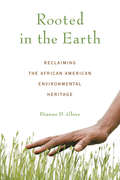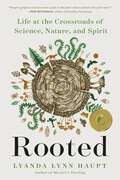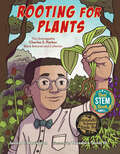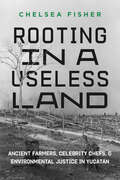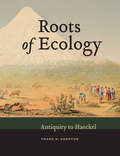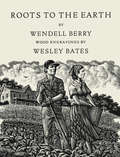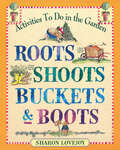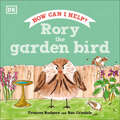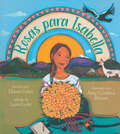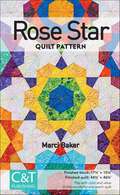- Table View
- List View
Role of Rhizospheric Microbes in Soil: Volume 2: Nutrient Management And Crop Improvement
by Vijay Singh MeenaIn any ecosystem, plant and microbe interaction is inevitable. They not only co-exist but also support each other’s survival and provide sustenance in stressful environments. Agro-ecosystems in many regions around the globe are affected by high temperatures, soil salinity/alkalinity, low pH and metal toxicity. High salinity and severe draught are other major constraints affecting agricultural practices and also plants in the wild. A major limiting factor affecting global agricultural productivity is environmental stresses. Apart from decreasing yield, they also have a devastating impact on plant growth. Plants battle with various kind of stresses with the help of symbiotic associations with the rhizospheric microbes. Naturally occuring plant-microbe interactions facilitate the survival of plants under these stressful conditions.The rhizosphere consists of several groups of microbes, plant growth-promoting bacteria (PGPB) is one such group of microbes that assists plants in coping with multiple stresses and also promote plant growth. These efficient microbes support the stress physiology of the plants and can be extremely useful in solving agricultural as well food- security problems.This book provides a detailed, holistic description of plant and microbe interaction. It elucidates various mechanisms of nutrient management, stress tolerance and enhanced crop productivity in the rhizosphere, discussing The rhizospheric flora and its importance in enhancement of plant growth, nutrient content, yield of various crops and vegetables as well as soil fertility and health. Divided into two volumes, the book addresses fundamentals, applications as well as research trends and new prospects for agricultural sustainability. Volume 1: Stress Management and Agricultural Sustainability, includes chapters offering a broad overview of plant stress management with the help of microbes. It also highlights the contribution of enzymatic and molecular events occurring in the rhizosphere due to plant microbe interactions, which in turn help in the biological control of plant disease and pest attacks. Various examples of plant microbe interaction in rhizospheric soil are elaborated to facilitate the development of efficient indigenous microbial consortia to enhance food and nutritional security. Providing a comprehensive information source on microbes and their role in agricultural and soil sustainability, this timely research book is of particular interest to students, academics and researchers working in the fields of microbiology, soil microbiology, biotechnology, agronomy, and the plant protection sciences, as well as for policy makers in the area of food security and sustainable agriculture.
Role of Rhizospheric Microbes in Soil: Volume 2: Nutrient Management and Crop Improvement
by Vijay Singh MeenaIn any ecosystem, plant and microbe interaction is inevitable. They not only co-exist but also support each other’s survival and also provide for sustenance in stressful environment. Agro-ecosystems of many regions around the globe are affected by multi-stress. Major limiting factors affecting the agricultural productivity worldwide are environmental stresses. Apart from decreasing yield they introduce devastating impact on plant growth as well. Plants battle with various kind of stresses with the help of symbiotic association with the microbes in the rhizosphere. Naturally existing plant-microbe interaction facilitates survival of plants under these stressful conditions. Rhizosphere consists of many groups of microbes, plant growth-promoting bacteria (PGPB) is one such group of microbes which assist plants in coping with multiple stresses and in plant growth as well. These microbes help in stress physiology of the plants and can be extremely useful in solving agricultural as well food security problems. The proposed book is split into two parts, with an aim to provide comprehensive description and highlight a holistic approach. It elucidates various mechanisms in rhizosphere of nutrient management, stress tolerance and enhanced crop productivity. The book discusses rhizospheric flora and its importance in enhancement of plant growth, nutrient content, yield of various crops and vegetables as well as soil fertility and health. Both volumes of the book addresses fundamentals, applications as well as research trends and new prospects of agricultural sustainability. Volume 2: Nutrient Management and Crop Improvement, contains chapters which cover a broad overview of plant growth promoting activities of microbes. This proposed book also highlights the contribution of nitrogen, phosphorus, potassium, iron and zinc-solubilizing microbes from rhizospheric soil to develop efficient indigenous microbial consortia to enhance the food and nutritional security. With the given content and layout the proposed book will be an all-inclusive collection of information, which will be useful for students, academicians, researchers working in the field of rhizospheric mechanisms, agricultural microbiology, soil microbiology, biotechnology, agronomy and sustainable agriculture and also for policy makers in the area of food security and sustainable agriculture. It will be of special interest to both academics and professionals working in the fields of microbiology, soil microbiology, biotechnology and agronomy, as well as the plant protection sciences. Timely, this edited and research book provides an essential and comprehensive source of material from basic to advance findings on microbes and their role in agricultural and soil sustainability.
Role of Science and Technology for Sustainable Future: Volume 1: Sustainable Development: A Primary Goal
by Ranbir Chander SobtiThe book explores the pivotal role of science and technology in achieving the sustainable development goals (SDGs) outlined in the agenda 2030 for sustainable development. It emphasizes the importance of integrating science and technology into developing strategies to promote a sustainable and prosperous global future. The book highlights the universal acceptance of the SDGs by United Nations member states, subnational governing bodies, and international organizations. It emphasizes that all stakeholders, including governmental bodies, private enterprises, and civil society, have a responsibility to contribute to the achievement of the SDGs. Science, technology, and innovation are identified as the three pillars essential for achieving the SDGs. The book emphasizes the critical role of science and technology in addressing complex issues such as climate change, biodiversity loss, resource depletion, poverty reduction, health, education, gender equality, clean energy, sustainable cities, responsible consumption, and climate action. It helps to develop innovative solutions to promote economic growth, social inclusion, and environmental sustainability. And provide the necessary knowledge and tools to develop effective policies and strategies in these areas. Furthermore, the book highlights the potential of science and technology in promoting innovation and entrepreneurship, leading to the creation of new businesses and industries that align with sustainable development principles. This fosters economic growth, job creation, and environmental sustainability. It advocates for continued investment in science and technology and their integration into development strategies. The book aims to provide insights into the role of traditional and emerging areas of science and technology in meeting the goals outlined in the SDG document, with a specific focus on India. The book serves as a great source of information for researchers, teachers in basic and applied sciences /social sciences research and policymakers.
Rolf in the Woods: The Adventures of a Boy Scout with Indian Quonab and Little Dog Skookum
by Ernest Thompson SetonSet at the beginning of the nineteenth century, Rolf in the Woods follows a young boy on his journey to becoming a man, learning how to live in the wilderness, respecting animals and nature, and fighting amongst his brethren in war. When his mother passes away, fifteen-year-old Rolf goes to live with his aunt and uncle on their farm. But his aunt's constant scolding and his uncle's drunken violence make living in this new home unbearable for the gentle boy, and he runs away to live in a wigwam with Quonab, a Native American, and his trusty dog Skookum, who teach the boy how to live off the land, hunt, gather, and understand wild creatures. These newfound skills come into play when Rolf must participate in the War of 1812, and he is able to survive by relying on the wisdom the Indian has shared with him. Rolf in the Woods is not only an adventure story but also a guide that teaches young men how to thrive in the outdoors. Ernest Thompson Seton, an avid outdoorsman, provides vivid descriptions of Quonab's lessons, like making a bed with logs, constructing a tom-tom, distinguishing the calls of animals, and making a bow and arrow, and includes over 200 hand-drawn illustrations to make these lessons come to life.
Roly the Hedgehog (Roly and Friends)
by Frances RodgersLet your little nature lover learn how to help the adorable animals that like to visit your yard.Meet Roly. She&’s a curious, prickly hedgehog who loves to explore yards, including yours! The yard can often be a dangerous place, and Roly needs your help to face these challenges. Are you in?This illustrated children&’s book about nature is perfect for gently introducing young readers to the idea of animal conservation and protection. It includes: • Beautifully illustrated spreads. • An engaging storyline that kids can follow and relate to, as the book refers to the wildlife that can be found in their own backyard or garden. • Fun-filled facts about hedgehogs. • A thoughtful and timely message about protecting wildlife, with tips for doing so. Join Roly on a garden adventure of a lifetime! Bursting with fun trivia and colorful illustrations, this sweet animal picture book shows kids just how unique hedgehogs are, which makes them worth preserving. Perfect for children ages 3-5, this wonderful preschool book provides animal-loving toddlers with plenty of helpful tips and tricks to help keep all their garden guests safe and roaming freely. It&’s the ultimate gift for curious children or budding environmentalists.Roly the Hedgehog is part of a beautiful series from DK that aims to inspire youngsters to discover so much of what is unseen in their yards, and teach them how to care for their yard-dwelling friends. Other titles in this series include Rory the Garden Bird, Roxy the Butterfly and Rosy the Bumblebee.
Romancing the Wild: Cultural Dimensions of Ecotourism
by Robert FletcherThe worldwide development of ecotourism—including adventures such as mountain climbing and whitewater rafting, as well as more pedestrian pursuits such as birdwatching—has been extensively studied, but until now little attention has been paid to why vacationers choose to take part in what are often physically and emotionally strenuous endeavors. Drawing on ethnographic research and his own experiences working as an ecotour guide throughout the United States and Latin America, Robert Fletcher argues that participation in rigorous outdoor activities resonates with the particular cultural values of the white, upper-middle-class Westerners who are the majority of ecotourists. Navigating 13,000-foot mountain peaks or treacherous river rapids demands deferral of gratification, perseverance through suffering, and a willingness to assume risks in pursuit of continuous progress. In this way, characteristics originally cultivated for professional success have been transferred to the leisure realm at a moment when traditional avenues for achievement in the public sphere seem largely exhausted. At the same time, ecotourism provides a temporary escape from the ostensible ills of modern society by offering a transcendent "wilderness" experience that contrasts with the indoor, sedentary, mental labor characteristically performed by white-collar workers.
Romania as an Energy Actor in the EU: Cooperation in European Energy policy (Europa Perspectives on the EU Single Market)
by Anca SineaThe purpose of this book is twofold. First, it aims to explain the general framework for cooperation in the energy sector in Europe, with a conceptual basis that allows for a better understanding of the dynamics that led to its existence. Second, the volume deals with Romania both as a representative case for the region, given the commonalities raised by the transition process in the last three decades, and also as a country with a specific energy agenda, with implications for internal and foreign policy that can only be perceived and understood in the Romanian context.
Romantic Anti-capitalism and Nature: The Enchanted Garden (Routledge Explorations in Environmental Studies)
by Michael Löwy Robert SayreRomantic Anti-capitalism and Nature examines the deep connections between the romantic rebellion against modernity and ecological concern with modern threats to nature. The chapters deal with expressions of romantic culture from a wide variety of different areas: travel writing, painting, utopian vision, cultural studies, political philosophy, and activist socio-political writing. The authors discuss a highly diverse group of figures - William Bartram, Thomas Cole, William Morris, Walter Benjamin, Raymond Williams, and Naomi Klein - from the late eighteenth to the early twenty-first century. They are rooted individually in English, American, and German cultures, but share a common perspective: the romantic protest against modern bourgeois civilisation and its destruction of the natural environment. Although a rich ecocritical literature has developed since the 1990s, particularly in the United States and Britain, that addresses many aspects of ecology and its intersection with romanticism, they almost exclusively focus on literature, and define romanticism as a limited literary period of the late eighteenth and early nineteenth centuries. This study is one of the first to suggest a much broader view of the romantic relation to ecological discourse and representation, covering a range of cultural creations and viewing romanticism as a cultural critique, or protest against capitalist-industrialist modernity in the name of past, pre-modern, or pre-capitalist values. This book will be of great interest to students and scholars of ecology, romanticism, and the history of capitalism.
Romantic Ecology: Wordsworth and the Environmental Tradition (Routledge Revivals)
by Jonathan BateFirst published in 1991, Romantic Ecology reassesses the poetry of William Wordsworth in the context of the abiding pastoral tradition in English Literature. Jonathan Bate explores the politics of poetry and argues that contrary to critics who suggest that the Wordsworth was a reactionary who failed to represent the harsh economic reality of his native Lake District, the poet’s politics were fundamentally ‘green’. As our first truly ecological poet, Wordsworth articulated a powerful and enduring vision of human integration with nature which exercised a formative influence on later conservation movements and is of immediate relevance to great environmental issues today. Challenging the orthodoxies of new historicist criticism, Jonathan Bate sets a new agenda for the study of Romanticism in the 1990s.
Romantic Things: a tree, a rock, a cloud
by Mary JacobusOur thoughts are shaped as much by what things make of us as by what we make of them. Lyric poetry is especially concerned with things and their relationship to thought, sense, and understanding. In Romantic Things, Mary Jacobus explores the world of objects and phenomena in nature as expressed in Romantic poetry alongside the theme of sentience and sensory deprivation in literature and art. Jacobus discusses objects and attributes that test our perceptions and preoccupy both Romantic poetry and modern philosophy. John Clare, John Constable, Rainer Maria Rilke, W. G. Sebald, and Gerhard Richter make appearances around the central figure of William Wordsworth as Jacobus explores trees, rocks, clouds, breath, sleep, deafness, and blindness in their work. While she thinks through these things, she is assisted by the writings of Maurice Merleau-Ponty, Jacques Derrida, and Jean-Luc Nancy. Helping us think more deeply about things that are at once visible and invisible, seen and unseen, felt and unfeeling, Romantic Things opens our eyes to what has been previously overlooked in lyric and Romantic poetry.
Rome
by Spiro Kostof Rabun Taylor Rinne Katherine WentworthSpanning the entire history of the city of Rome from Iron Age village to modern metropolis, this is the first book to take the long view of the Eternal City as an urban organism. Three thousand years old and counting, Rome has thrived almost from the start on self-reference, supplementing the everyday concerns of urban management and planning by projecting its own past onto the city of the moment. This is a study of the urban processes by which Rome's people and leaders, both as custodians of its illustrious past and as agents of its expansive power, have shaped and conditioned its urban fabric by manipulating geography and organizing space; planning infrastructure; designing and presiding over mythmaking, ritual, and stagecraft; controlling resident and transient populations; and exploiting Rome's standing as a seat of global power and a religious capital.
Romewalks
by Anya M. ShetterlyThe secret of all cities is to be found in their streets and neighborhoods. This is especially true of Rome. What distinguishes this guidebook to Rome from so many others is that it explores neighborhoods instead of merely describing monuments. By taking the reader on walks through the streets around the Campo dei Fiori, the Piazza Noavona, the Jewish Ghetto, and Trastevere, and by paying close attention to architecture, local history and people, art, religion, archeology, and, of course, cuisine, Romewalks by Anya M. Shetterly offers a remarkably intimate and comprehensive look at the city and its history. Also included in this guidebook are maps of each of the four walks, photographs, a concise section of information and advice, a list of specially selected restaurants and shops, and an index.
Root to Stem: A seasonal guide to natural recipes and remedies for everyday life
by Alex Laird'Root to Stem is a seasonal and holistic approach to health that puts plants, herbs and nature at the heart of how we live and eat. It is a new kind of guide that links individual health to our communities and the planet's health to sustain us all.'This perfect companion to the seasons, this book will show you how to take greater control over your own health and well-being, treat everyday ailments, and ensure the sustainability of the planet through discovering how to forage, grow, or shop for plant- and herb-based foods and products. Including: Detox in the spring with sorrel, cleavers and nettles. Harvest summer lime leaf shoots to soothe digestive upsets and feed gut microbes. Bake a Lammas loaf to celebrate the autumnal equinox. Boost your winter immunity with red berries, purple potatoes and rosehips. Root-to-stem eating encourages you to use every edible part of plant, including the leaves, skin, seeds and stalks.Travelling through the four seasons, expert medical herbalist Alex Laird shares the natural ingredients that are available on your doorstep, simple delicious recipes and easy-to-make herbal remedies.
Rooted in Wonder: Nurturing Your Family's Faith Through God's Creation
by Eryn LynumMasterfully connects Scripture to nature and nature to God.--Lori Wildenberg, national speaker, parent coach, and authorFor a generation whose eyes are constantly trained on screens, encountering nature at all is increasingly difficult, much less seeing what it reveals about God. How can parents help children reengage with God's world that is full of amazement, creativity, and love?Eryn Lynum is a certified master naturalist, Bible teacher, and mom of four who wants to help families encounter and understand the connection between God and creation. She shares her own story of putting her kids in front of nature, and invites other parents to consider a similar journey.With practical sections that look at nature through the lens of the Bible and activities to integrate faith and the natural world, Rooted in Wonder helps parents instill within their kids an unshakable faith. Through the art of play, the drive of discovery, and the awe of adventure, children will gain a sense of wonder in their Creator that will last a lifetime."With joy and practical know-how, Eryn Lynum helps parents connect the beauty of creation with love for the Creator. Rooted in Wonder is a must-read for helping the next generation to get outdoors and get to know God."--Matthew Sleeth, MD, executive director of Blessed Earth
Rooted in the Earth: Reclaiming the African American Environmental Heritage
by Dianne GlaveWith a basis in environmental history, this groundbreaking study challenges the idea that a meaningful attachment to nature and the outdoors is contrary to the black experience. The discussion shows that contemporary African American culture is usually seen as an urban culture, one that arose out of the Great Migration and has contributed to international trends in fashion, music, and the arts ever since. But because of this urban focus, many African Americans are not at peace with their rich but tangled agrarian legacy. On one hand, the book shows, nature and violence are connected in black memory, especially in disturbing images such as slave ships on the ocean, exhaustion in the fields, dogs in the woods, and dead bodies hanging from trees. In contrast, though, there is also a competing tradition of African American stewardship of the land that should be better known. Emphasizing the tradition of black environmentalism and using storytelling techniques to dramatize the work of black naturalists, this account corrects the record and urges interested urban dwellers to get back to the land.
Rooted: Life at the Crossroads of Science, Nature, and Spirit
by Lyanda Lynn HauptDeepen your connection to the natural world with this inspiring meditation, "a path to the place where science and spirit meet" (Robin Wall Kimmerer).In Rooted, cutting-edge science supports a truth that poets, artists, mystics, and earth-based cultures across the world have proclaimed over millennia: life on this planet is radically interconnected. Our bodies, thoughts, minds, and spirits are affected by the whole of nature, and they affect this whole in return. In this time of crisis, how can we best live upon our imperiled, beloved earth?Award-winning writer Lyanda Lynn Haupt&’s highly personal new book is a brilliant invitation to live with the earth in both simple and profound ways—from walking barefoot in the woods and reimagining our relationship with animals and trees, to examining the very language we use to describe and think about nature. She invokes rootedness as a way of being in concert with the wilderness—and wildness—that sustains humans and all of life.In the tradition of Rachel Carson, Elizabeth Kolbert, and Mary Oliver, Haupt writes with urgency and grace, reminding us that at the crossroads of science, nature, and spirit we find true hope. Each chapter provides tools for bringing our unique gifts to the fore and transforming our sense of belonging within the magic and wonder of the natural world.
Rooting for Plants: The Unstoppable Charles S. Parker, Black Botanist and Collector
by Janice N. HarringtonMeet Charles S. Parker, an unsung yet trailblazing Black scientist who made major contributions to the fields of botany (the study of plants) and mycology (the study of fungi) in this inspiring STEM/STEAM picture book biography.In 1882, Black botanist and mycologist Charles S. Parker sprouted up in the lush, green Pacific Northwest. From the beginning, Charles&’s passion was plants, and he trudged through forests, climbed mountains, and waded into lakes to find them. When he was drafted to fight in World War I, Charles experienced prejudice against Black soldiers and witnessed the massive ecological devastation that war caused. Those experiences made him even more determined to follow his dreams, whatever the difficulties, and to have a career making things grow, not destroying them.As a botanist and teacher, Charles traveled the United States, searching for new species of plants and fungi. After discovering the source of the disease killing peach and apricot trees, Charles was offered a job at Howard University, the famed historically Black college where he taught the next generation of Black scientists—men and women—to love plants and fungi as much as he did.
Rooting in a Useless Land: Ancient Farmers, Celebrity Chefs, and Environmental Justice in Yucatan
by Chelsea FisherIn Rooting in a Useless Land, Chelsea Fisher examines the deep histories of environmental-justice conflicts in Mexico's Yucatán Peninsula. She draws on her innovative archaeological research in Yaxunah, an Indigenous Maya farming community dealing with land dispossession, but with a surprising twist: Yaxunah happens to be entangled with prestigious sustainable-development projects initiated by some of the most famous chefs in the world. Fisher contends that these sustainable-development initiatives inadvertently bolster the useless-land narrative—a colonial belief that Maya forests are empty wastelands—which has been driving Indigenous land dispossession and environmental injustice for centuries. Rooting in a Useless Land explores how archaeology, practiced within communities, can restore history and strengthen relationships built on contested ground.
Roots of Ecology
by Frank N. EgertonEcology is the centerpiece of many of the most important decisions that face humanity. Roots of Ecology documents the deep ancestry of this now enormously important science from the early ideas of Herodotos, Plato, and Pliny, up through those of Linnaeus and Darwin, to those that inspired Ernst Haeckel's mid-nineteenth-century neologism ecology. Based on a long-running series of regularly published columns, this important work gathers a vast literature illustrating the development of ecological and environmental concepts, ideas, and creative thought that has led to our modern view of ecology. Roots of Ecology should be on every ecologist's shelf.
Roots to the Earth: Poems And A Story
by Wendell Berry Wesley BatesIn 1995, Wendell Berry's Roots to the Earth was published in portfolio form by West Meadow Press. The wood etchings of celebrated artist and wood engraver, Wesley Bates, were printed from the original wood blocks on handmade Japanese paper.In 2014, this work was reprinted along with additional poems. Together with Bates' original wood engravings, and designed by Gray Zeitz, Larkspur Press printed just one hundred copies of this book in a stunning limited edition.Now it is with great pleasure that Counterpoint is reproducing this collaborative work for trade publication, as well as expanding it with the inclusion of a short story, "The Branch Way of Doing," with additional engravings by Bates.In his introduction to the 2014 collection, Bates wrote: "As our society moves toward urbanization, the majority of the population views agriculture from an increasingly detached position... In his poetry [Berry] reveals tenderness and love as well as anger and uncertainty... The wood engravings in this collection are intended to be companion pieces to... the way he expresses what it is to be a farmer."
Roots, Shoots, Buckets & Boots: Gardening Together with Children
by Sharon LovejoyPlant a pumpkinseed with a child, and cultivate wonder. This simple act of reconnecting with children with nature is Sharon Lovejoy's purpose and joy and gift. Author of Sunflower Houses: Garden Discoveries for Children of All Ages and Hollyhock Days: Garden Adventures for the Young at Heart, Sharon Lovejoy is a nationally known garden writer whose books, television specials, and projects at her learning landscape in California have introduced thousands of children to the pleasures of gardening.In her newest book, Roots, Shoots, Buckets & Boots, she presents 12 spirited, easy-to-implement ideas for theme gardens that parents and kids can grow together. Illustrated throughout by the author's own lyrical watercolors, each garden includes a plan, the planting recipe -- seeds, seedlings, and growing instructions spelled out step-by-step -- and activities. There's the Pizza Patch , a giant-size wheel garden planted in "slices" of tomatoes, zucchini, oregano, and basil. A Flowery Maze to get lost in. A Moon Garden of night-blooming flowers, including a moonflower tent. And Mother Nature's Medicine Chest.Discovery Walks teach kids how the gardens work, and a chapter on gardening basics includes a child-friendly 10-Minute Plan for planting and maintenance, plus a list of the top 20 plants guaranteed to make gardeners out of kids.
Rory the Garden Bird (Roly and Friends #Vol. 3)
by Frances RodgersPerfect for little animal lovers, this beautiful early learning book shows you how to help adorable animals that like to visit your yard.Meet Rory. He&’s a small, inquisitive bird who loves to visit yards and gardens, including yours! From stinky rubbish to hungry cats, the yard can sometimes be a dangerous place. Will you volunteer to help keep him safe?This illustrated children&’s book about nature is perfect for gently introducing young readers to the idea of animal conservation and protection. It includes: • Beautifully illustrated spreads. • An engaging storyline that kids can follow and relate to, as the book refers to the wildlife that can be found in their own backyard or garden. • Fun-filled facts about birds. • A thoughtful and timely message about protecting wildlife, with tips for doing so. Join Rory as he sets off into the yard, finding yummy bird mix to munch on and a cozy spot in the trees to rest in after a long, hard day of exploring. Bursting with fun trivia and colorful illustrations, this sweet animal picture book shows kids just how unique birds are, which makes them worth preserving. Perfect for children ages 3-5, this wonderful preschool book provides nature-loving toddlers with plenty of helpful tips and tricks to help keep all their yard guests safe and roaming freely. It&’s the ultimate gift for curious children or budding environmentalists.Rory the Garden Bird is part of a beautiful series from DK that aims to inspire youngsters to discover so much of what is unseen in their yards, and teach them how to care for their yard-dwelling friends. Other titles in this series include Roly the Hedgehog, Roxy the Butterfly and Rosy the Bumblebee.
Rosas para Isabella (Roses for Isabella)
by Diana Cohn¡Detente y huele las rosas del Ecuador con Isabella, mientras ella aprende cómo tratar a los trabajadores agrícolas y a la Madre Tierra de una manera justa hace que el mundo florezca! Also available in English. Stop and smell the roses of Ecuador with Isabella as she learns how treating farmworkers and Mother Earth fairly makes the world bloom!A Isabella le encanta escribir, especialmente sobre las flores vibrantes que sus padres cultivan como trabajadores agrícolas. Cuando su profesora anuncia un concurso de escritura para una asamblea escolar en honor a la Pachamama, la Madre Tierra, Isabela decide escribir sobre las fincas de rosas en donde "rosas rosadas, rojas, amarillas y anaranjadas crecen en filas que no terminan nunca". En dulces poemas y anotaciones en su diario, Isabella menciona cómo sus padres se sienten mucho mejor trabajando en una nueva finca de Comercio Justo. La finca toma varias medidas para mantener seguros tantos a los trabajadores agrícolas como al medio ambiente, como tratar de no usar pesticidas peligrosas que hacen que la gente, especialmente trabajadores agrícolas, se enfermen. Con un texto claro y alegre de la premiada autora Diana Cohn e ilustraciones cautivadoras, Rosas para Isabela presenta a los lectores las tradiciones culturales del Ecuador y la importancia de tomar decisiones que apoyen a los trabajadores agrícolas y al medio ambiente. La premiada ilustradora Amy Córdova Boone presenta el mundo de Isabela en obras de arte tan vibrantes como sus amadas flores. ¡Únete a Isabela en esta celebración de los trabajadores agrícolas y los hermosos regalos que recibimos de la Madre Tierra! Isabella loves to write, especially about the vibrant flowers her parents grow as farmworkers. When her teacher announces a school writing contest in honor of Pachamama, Mother Earth, Isabella decides to write about the rose farms where "pink, red, yellow, and orange roses grow in rows that go on forever." In sweet poems and journal entries, Isabella notes how her parents feel much better working at a new Fair Trade farm. This new farm takes a lot of steps to keep both farmworkers and the environment safe, like avoiding dangerous pesticides that make people, especially farmworkers, sick. With clear, joyful text by award-winning author Diana Cohn, and captivating illustrations, Roses for Isabella introduces readers to the cultural traditions of Ecuador and the importance of making choices that support farmworkers and the environment. Award-winning illustrator Amy Córdova Boone presents Isabella's world in artwork as vibrant as her beloved flowers. Join Isabella in this celebration of farmworkers and the beautiful gifts we receive from Mother Earth!
Rose Recipes from Olden Times
by Eleanour Sinclair RohdeEven though nowadays roses are cultivated mostly for their beauty, previous ages have not been so singularly narrow-minded. Even at the turn of the century many people in appreciation of the fragrance, sweet flavor, and medicinal virtues of rose petals, hips, and leaves, still took pleasure in age-old traditional ways of making perfumes, sweet waters, jams, jellies, salads, sauces, and various kinds of confections with roses. They also knew how to crystallize the petals, to preserve the buds, to flavor wines and vinegar with rose leaves, and to use roses in many medicinal ways.With thanks in great measure to the extraordinary modern herbalist Eleanour Sinclair Rohde, this wonderful knowledge has not vanished beyond recall. Her collection of rose recipes between these covers is gathered from the works of a variety of old herbalists (notably Sir Hugh Platt, Gervase Markham, and Sir Kenelm Digby), as well as from her own vast knowledge of traditional herbal recipes. "Receipts" from four centuries include: pot-pourris, sweet bags and pomanders (using dried roses with such extra ingredients as mint, cloves, coriander, lavender flowers, and sandalwood); sweet waters (with ingredients like nutmeg, cardamom, orange peel, and cloves) that can be used for washing; perfumes, oil of roses, and "odoriferous" candles; and a host of culinary delights like conserves (both petals and hips), sauce eglantine, rossoly, rose jelly, rose hip marmalade, and pickled rosebuds.There are 83 recipes altogether, including instructions on how to dry rose leaves (four ways), how to candy rose leaves, how to preserve whole roses, and how to flavor sugar, wine, vinegar, and honey with roses. Every page is beautifully and distinctively decorated, making this not only a source of special joy for connoisseurs of herbs and herbals, but in all ways a pleasure to read and use for anyone wanting the best rose recipes.
Rose Star Quilt Pattern
by Marci BakerBlooming flowers…shining stars! A brilliant single-patch design to grow your piecing skills Slice a stack of simple teardrops for a hexagon-shaped quilt with unlimited possibilities. Understand color placement and value like never before with best-selling author Marci Baker. Use your designer’s eye to guide you, creating an illusion of colorful stars and vivacious flower bursts. Rotary cutting is even easier with the Clearview Triangle 60° Acrylic Ruler in any size–6", 8", 10", or 12"–or the Clearview Triangle Super 60 ! • Vibrant hexagonal quilt top from one-patch blocks • Learn how to mix fabrics of differing values for stunning effects • Can be used with the Clearview Triangle Super 60 Acrylic Ruler or any size Clearview Triangle 60° Acrylic Ruler (Wholesale minimum: 3 units.)
